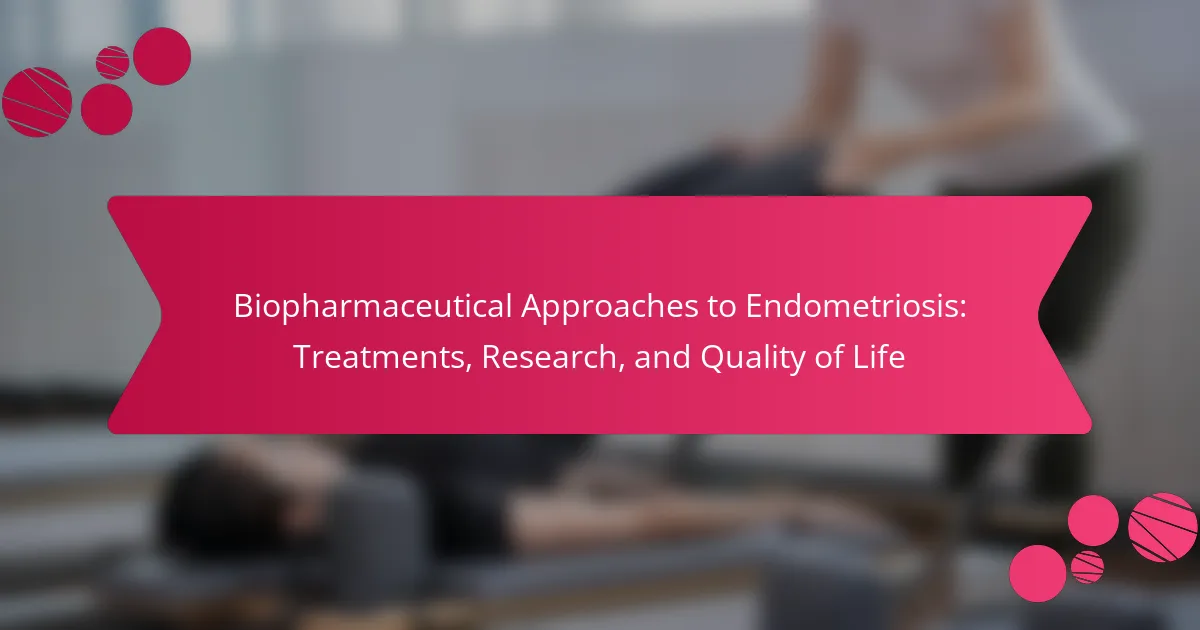Biopharmaceutical approaches to endometriosis offer promising treatments that aim to alleviate pain and enhance quality of life. This article explores various therapies, including hormonal treatments and GnRH agonists, while highlighting ongoing research into targeted therapies and personalised medicine. It also addresses the challenges of accessing these treatments globally and emphasises the importance of informed decision-making in treatment planning.

What are the main biopharmaceutical treatments for endometriosis?
Biopharmaceutical treatments for endometriosis primarily include hormonal therapies, GnRH agonists, and aromatase inhibitors. Hormonal therapies manage symptoms by regulating oestrogen levels, while GnRH agonists induce a temporary menopause-like state to reduce endometrial tissue. Aromatase inhibitors block oestrogen production, offering an alternative approach. These treatments aim to alleviate pain and improve quality of life for patients. Recent research focuses on developing new agents targeting specific pathways involved in endometriosis, enhancing treatment efficacy and minimising side effects.
How do hormonal therapies work in managing endometriosis symptoms?
Hormonal therapies manage endometriosis symptoms by regulating hormonal levels to reduce pain and lesions. These therapies often involve the use of contraceptives, progestins, or GnRH agonists, which aim to suppress menstruation and decrease oestrogen production. As a result, hormonal therapies can alleviate pain and improve quality of life for patients. Research indicates that continuous use of these therapies can lead to a significant reduction in symptom severity, enhancing overall well-being.
What role do non-hormonal treatments play in endometriosis care?
Non-hormonal treatments play a crucial role in managing endometriosis symptoms and improving quality of life. These approaches include pain relief medications, dietary changes, and physical therapy. Non-hormonal options can reduce inflammation and alleviate pain without the side effects associated with hormonal therapies. Recent research highlights the effectiveness of integrative methods, such as acupuncture and mindfulness, which can enhance overall well-being for patients. Non-hormonal treatments offer a valuable alternative for those seeking to avoid hormonal interventions while managing their condition.
Which emerging biopharmaceuticals show promise in clinical trials?
Several emerging biopharmaceuticals show promise in clinical trials for endometriosis treatment. Notably, therapies targeting the hormonal pathways and inflammation have demonstrated effectiveness. For instance, ELT-001, a novel GnRH antagonist, has shown significant reduction in pain scores. Additionally, therapies like Ovarian Suppression and Anti-Inflammatory Agents are under investigation, with early results indicating improved quality of life for patients. These advancements may redefine treatment options and enhance patient outcomes.

How is ongoing research shaping the future of endometriosis treatment?
Ongoing research is significantly enhancing endometriosis treatment through innovative biopharmaceutical approaches. These advancements focus on targeted therapies that aim to alleviate symptoms and improve quality of life. Recent studies explore the efficacy of novel drug compounds and biologics, which show promise in reducing inflammation and pain associated with the condition. Additionally, research on genetic markers and biomarkers is paving the way for personalised treatment plans, enabling tailored interventions for individual patients. As a result, the future of endometriosis management is increasingly centred on precision medicine, aiming for better outcomes and fewer side effects.
What innovative approaches are being explored in biopharmaceutical research?
Innovative approaches in biopharmaceutical research for endometriosis include gene therapy, monoclonal antibodies, and personalised medicine. These strategies aim to target specific pathways involved in the disease, improving treatment efficacy and patient quality of life. For example, monoclonal antibodies can inhibit inflammatory processes linked to endometriosis, potentially reducing symptoms. Additionally, gene therapy holds promise for correcting underlying genetic factors contributing to the condition. Personalised medicine tailors treatments based on individual patient profiles, enhancing outcomes and minimising side effects.
How are patient outcomes being measured in current studies?
Current studies measure patient outcomes in endometriosis through various metrics like pain reduction, quality of life improvements, and treatment efficacy. These evaluations often utilise standardised questionnaires and clinical assessments to quantify changes in symptoms and overall well-being. For example, the Visual Analog Scale (VAS) is frequently used to assess pain levels, while the Endometriosis Health Profile (EHP-30) gauges quality of life. Researchers also track medication adherence and side effects to understand treatment impacts comprehensively.
Which organizations are leading research efforts in this field?
Leading organizations in biopharmaceutical research for endometriosis include the National Institutes of Health (NIH), the Endometriosis Foundation of America, and the World Endometriosis Society. These entities focus on innovative treatments and improving patient quality of life through extensive studies and clinical trials. Their collaborative efforts aim to enhance understanding and management of endometriosis, contributing significantly to advancements in this field.

What impact do biopharmaceutical approaches have on quality of life for patients?
Biopharmaceutical approaches significantly enhance the quality of life for patients with endometriosis. These treatments target the underlying mechanisms of the disease, leading to improved symptom management and reduced pain. Research indicates that therapies like monoclonal antibodies and hormone modulators can decrease inflammation and regulate hormonal imbalances, resulting in fewer flare-ups and better daily functioning. As a result, patients often report enhanced physical and emotional well-being, contributing to a more active lifestyle and improved relationships.
How do treatments affect daily living and mental health?
Biopharmaceutical treatments for endometriosis significantly enhance daily living and mental health. These therapies can alleviate pain, improve physical function, and reduce psychological distress. Research indicates that effective management of symptoms leads to better quality of life outcomes, fostering emotional well-being. Patients often report increased energy levels and improved social interactions as a result of effective treatment.
What are the common challenges faced by patients during treatment?
Patients often face several challenges during endometriosis treatment, including pain management, emotional stress, and medication side effects. Access to specialised care can be limited, affecting treatment options. Additionally, the complexity of treatment plans may lead to confusion and non-adherence. Financial burdens from ongoing treatments can also impact quality of life.
Which support systems are beneficial for managing life with endometriosis?
Support systems that are beneficial for managing life with endometriosis include medical professionals, support groups, and holistic therapies. Access to knowledgeable healthcare providers ensures proper treatment and management strategies. Support groups provide emotional and social support, helping individuals share experiences and coping strategies. Holistic therapies, such as acupuncture and mindfulness, may alleviate symptoms and enhance quality of life. Integrating these support systems can empower individuals to navigate the challenges of endometriosis more effectively.

What are the unique challenges of accessing biopharmaceutical treatments globally?
Accessing biopharmaceutical treatments globally presents unique challenges, including regulatory disparities, supply chain issues, and economic barriers. Regulatory environments vary significantly, complicating approval processes. Additionally, logistical hurdles can impede the distribution of these therapies, especially in remote areas. Economic factors, such as high costs and varying insurance coverage, further limit access to effective treatments for endometriosis.
How do healthcare systems in different regions affect treatment availability?
Healthcare systems in different regions significantly influence treatment availability for endometriosis. Access to biopharmaceutical approaches varies based on regional healthcare policies, funding, and infrastructure.
In regions with robust healthcare systems, patients may have better access to advanced treatments and ongoing research initiatives. For example, countries with comprehensive insurance coverage often provide a wider range of treatment options, including newer biopharmaceuticals. Conversely, areas with limited resources may face shortages in medication availability and specialist care.
Research funding also differs by region, impacting the development of new therapies. Regions investing heavily in women’s health research typically see more innovative treatment options emerging for endometriosis.
Quality of life for patients can vary based on treatment access, with those in well-resourced areas experiencing improved outcomes and support services. This disparity underscores the importance of equitable healthcare access in managing endometriosis effectively.
What financial considerations should patients be aware of?
Patients should be aware of various financial considerations related to biopharmaceutical treatments for endometriosis. These can include medication costs, insurance coverage, copayments, and potential out-of-pocket expenses.
Many biopharmaceutical therapies can be expensive, and insurance plans may vary in their coverage. Some patients may qualify for financial assistance programs offered by pharmaceutical companies. Understanding the specific benefits of one’s insurance plan can help mitigate costs.
Additionally, patients should consider the long-term financial impact of ongoing treatment and any potential loss of income due to the condition. Planning for these expenses can improve overall quality of life and treatment adherence.
Which advocacy groups are working to improve access to treatments?
Several advocacy groups work to improve access to treatments for endometriosis. Notable organizations include the Endometriosis Foundation of America, which focuses on education and awareness, and the Endometriosis Association, dedicated to supporting those affected and promoting research. Additionally, the American Society for Reproductive Medicine advocates for improved treatment options and access to care. These groups aim to enhance patient quality of life through increased awareness, research funding, and policy advocacy.

What best practices should patients follow when considering biopharmaceutical options?
Patients should consult healthcare professionals and consider personalised factors before choosing biopharmaceutical options for endometriosis. Understanding treatment efficacy, potential side effects, and the latest research is essential.
1. Discuss treatment goals with your healthcare provider.
2. Evaluate the latest clinical studies related to biopharmaceuticals.
3. Assess personal health history and current medications.
4. Consider potential side effects and management strategies.
5. Stay informed about emerging biopharmaceutical research.
How can patients effectively communicate with their healthcare providers?
Patients can effectively communicate with their healthcare providers by preparing questions and being clear about their symptoms. Active listening and taking notes during appointments enhance understanding. Sharing concerns openly fosters trust and collaboration. Utilizing patient portals for follow-up questions can also improve communication.
What common mistakes should patients avoid during their treatment journey?
Patients should avoid common mistakes such as neglecting to communicate symptoms, skipping prescribed treatments, and not attending follow-up appointments. These errors can hinder the effectiveness of biopharmaceutical approaches to endometriosis and negatively impact quality of life.
Additionally, patients should be cautious about relying solely on online information without consulting healthcare professionals. Misunderstanding treatment options can lead to poor decision-making. Staying informed and engaged in the treatment process is essential for optimal outcomes.
What strategies can enhance adherence to prescribed therapies?
Enhancing adherence to prescribed therapies can be achieved through several strategies. Effective communication between healthcare providers and patients fosters trust and understanding. Personalised treatment plans that consider individual preferences increase engagement. Regular follow-ups and reminders support ongoing commitment. Educational resources about endometriosis and treatment benefits empower patients to take charge of their health. Utilizing mobile health technologies can facilitate real-time tracking and feedback, promoting accountability.
